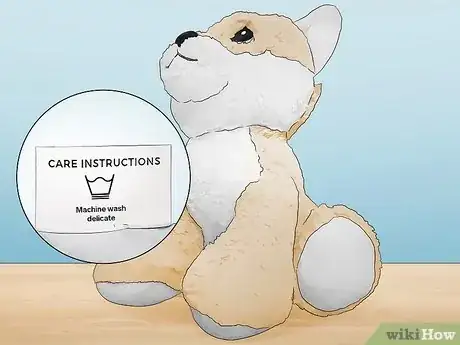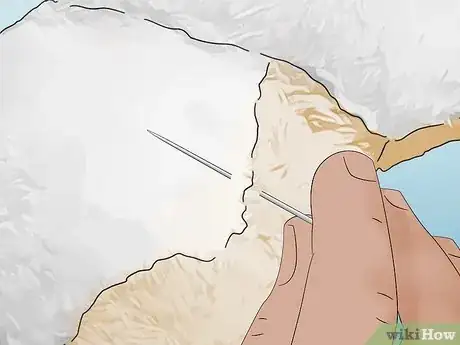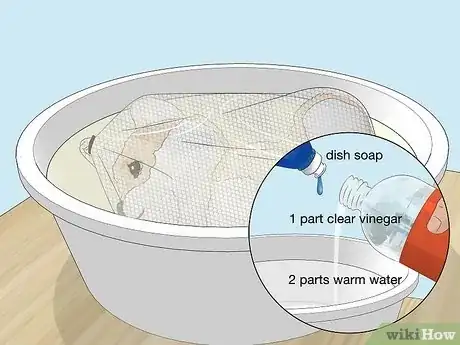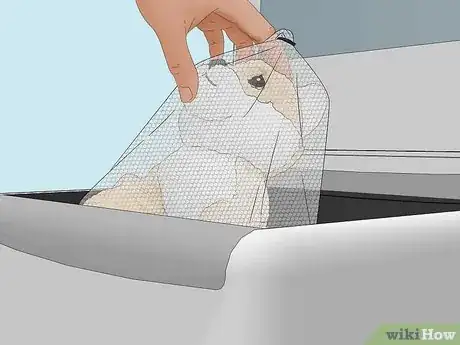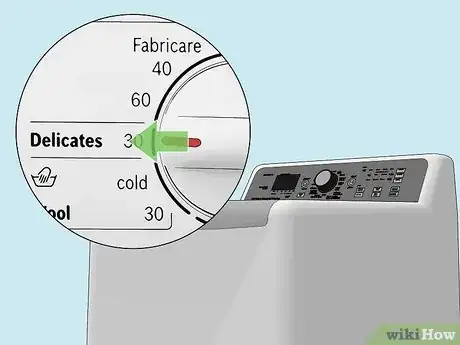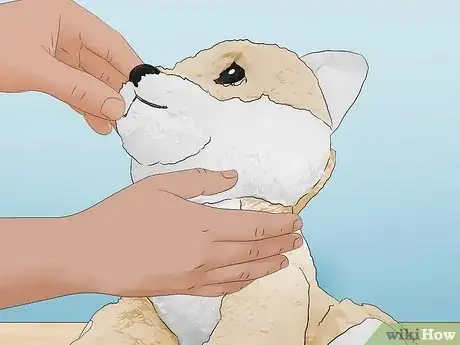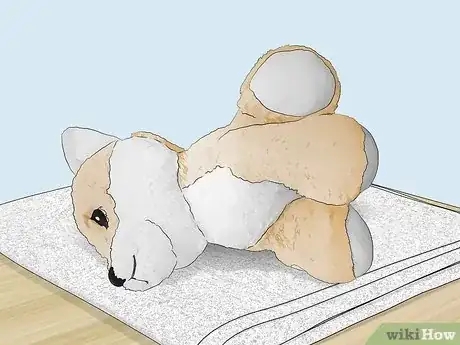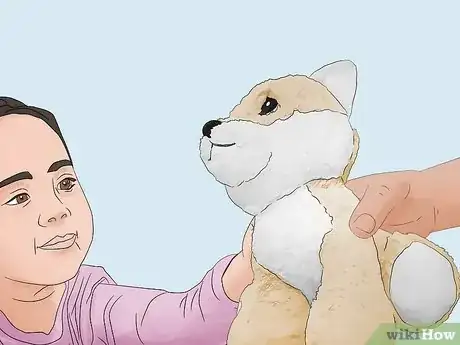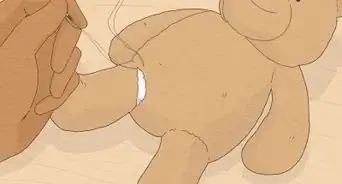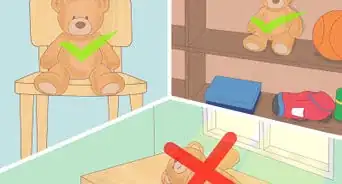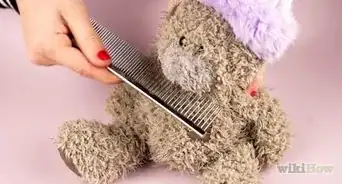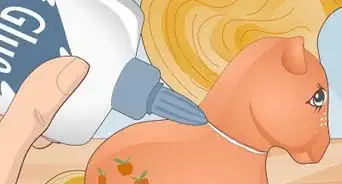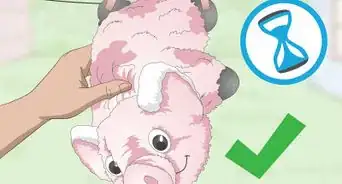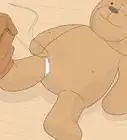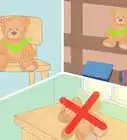This article was co-authored by Claudia & Angelo Zimmermann. Claudia and Angelo Zimmermann are the founders of Everneat, an Eco-Friendly Cleaning Service based in New York City and in Connecticut. They are also the founders of Clean Code, a DIY 100% natural cleaning product line.
There are 7 references cited in this article, which can be found at the bottom of the page.
This article has been viewed 302,830 times.
After being fiercely loved and lugged around for years, plush toys and stuffed animals can get more than a bit scruffy. And if you're donating, many charities will not take stuffed animals unless they have been washed. Surface washing can't always get to all of the hard spots. Scrubbing and harsh chemicals may get out stains, but they can also damage fabric or cause colors to fade. Sometimes the best option is to machine wash a stuffed toy. By taking the proper precautions, you can wash your plush or stuffed animal without ruining it!
Steps
Preparing to Machine Wash
-
1Make sure that your plush toy's fabric is washable. Check to see if it has a tag with washing instructions. Toys with any types of stiffeners should be surface washed only. Mohair, wool, rayon plush, and alpaca fur are not to be washed in a machine at all. And if the toy is too old and fragile, too big, or too firmly stuffed, you'll have to hand wash it.[1]
- Sequins or other glued-on, glittery items will probably not survive a wash, either.
- If it's filled with small foam balls, as is the case with Beanie Babies, rather than batting or stuffing, it's not suitable for machine washing.
- Double check for any technology. Look for any music or voice boxes, or any other electronics that aren't meant for exposure to water. If your toy has electronics, cleaning specialist Claudia Zimmerman says you can "spot clean the surface with soapy water and a microfiber cloth. Then, remove the soapy residue with a damp microfiber cloth [dipped in] warm water."
-
2Remove or secure loose parts. Make sure you don't lose Teddy's arm in the wash! Look for any tears or loose parts that need to be stitched. Remove clothing or any other parts that can be separated from the toy. Use scissors to cut any threads or strings that might come undone or cause further damage in the wash.[2]Advertisement
-
3Use a mesh laundry bag. Put the toy inside a mesh laundry bag for an extra layer of protection. This will help prevent the toy from snagging or getting torn up in the wash. If you don't have one handy, a pillowcase secured with safety pins will work. In case something does fall off, the pillowcase or mesh bag will catch it before it gets lost in the machine's drain.[3]
Using the Washing Machine
-
1Presoak with a vinegar solution. Vinegar is a great natural fabric softener, and works great for common kid-related messes that might involve vomit or urine.[4] Mix one part clear vinegar with two parts warm water and dash of lemon juice or dish detergent.
- You can pour the diluted vinegar solution right into the laundry bag and let it soak before putting in the machine wash.
- If anything is caked onto the stuffed toy, use a sponge liberally soaked in the solution to get any messy matter off before tossing it in the mesh bag.
-
2Place the toy and detergent inside the washer. If you have a top-loader that doesn't have a separate compartment for detergent, get the water running and put down detergent before you place the toy inside. It's best to use a machine without an agitator. Never use a high-powered laundromat machine.[5]
- Use a very small amount of mild detergent, such as Woolite, or just use the vinegar solution you made. If you go with detergent, a teaspoon or so will do, depending on the size of the stuffed animal.[6]
- Soap nuts also have hypoallergenic properties, which are good if your child has a dust mite allergy.
- Fabric softener is normally unnecessary and can harm the plush. Instead, you can add distilled white vinegar to the rinse cycle to deodorize the toy and remove any detergent residue.
-
3Set the washer on cold and use gentle cycle. The gentlest cycle possible will reduce the risk of parts torn off. Don't use hot water, or you'll discolor the stuffed animal. Hot water is especially harmful for any glued parts the toy might have.[7]
Drying a Stuffed Toy
-
1Reshape the stuffed animal. When you remove the toy from the mesh bag, you might find that the washing machine has left the stuffed toy lumpy or bumpy. Before letting it dry, check for any balled up batting. Gently work it out with your fingers and fluff while it's still damp for best results.[8]
-
2Hang dry. Most stuffed toys should be air dried. A dryer's heat, even on low, can melt or damage any glue, plastic, or even the fabric of the stuffed toy. Lay it out on a dry towel, or use a clamp hanger or S-hooks to hang it. [9] If you have any concern about allergies, hang the stuffed animal inside so it won't pick up any pollen or other allergens. Note well, however, that direct sunlight is an efficient dryer, and the sun's ultraviolet light also has disinfectant properties.[10]
-
3Primp and return to your child. Use a dental pick to pick out knots in the fur, or a fine comb to give it a little more fluff. If the toy isn't too fragile, you could tumble it in the dryer with a few towels for ten minutes for added fluff and softness, but make sure it's set to no heat. Double check to make sure everything is stitched, no threads need to be cut, and that the toy is in good shape, and return it clean and fresh to your youngster.[11]
Community Q&A
-
QuestionCan an all polyester stuffed animal be machine washed
 Community AnswerDouble check to see if it has any tags with washing instructions. Not all polyester stuffed animals can be washed, but most polyester fabrics are machine washable. Does the stuffed animal have any parts that could easily be torn off in the wash? How about sequins or other glued-on bits? If so, hand-washing is best. If the stuffed animal is all polyester with none of these other materials, give machine washing a try, but use a gentle cycle and cold water.
Community AnswerDouble check to see if it has any tags with washing instructions. Not all polyester stuffed animals can be washed, but most polyester fabrics are machine washable. Does the stuffed animal have any parts that could easily be torn off in the wash? How about sequins or other glued-on bits? If so, hand-washing is best. If the stuffed animal is all polyester with none of these other materials, give machine washing a try, but use a gentle cycle and cold water. -
QuestionAt what temperature soft toys to be washed in machine
 Community AnswerAlways use cold water temperature to reduce discoloring. Don't use a dryer, as heat can damage glue, plastic, or fabric.
Community AnswerAlways use cold water temperature to reduce discoloring. Don't use a dryer, as heat can damage glue, plastic, or fabric.
Warnings
- If washed too often, the toy can wear out its fabric.⧼thumbs_response⧽
- Too much sun exposure will fade some stuffed animals.⧼thumbs_response⧽
Things You'll Need
- A dirty stuffed toy
- Needle, thread, and thimble (optional)
- Mesh laundry bag or pillowcase and safety pins
- Gentle laundry detergent
- A washing machine with cool and gentle cycles (not the laundromat!)
- A drying towel or clamp hanger
- A sunny windowsill or veranda
- A dryer (optional)
- Dental pick or fine comb
References
- ↑ http://www.mamaslaundrytalk.com/how-to-wash-stuffed-animals/
- ↑ http://www.stain-removal-101.com/washing-stuffed-animals.html
- ↑ http://www.stain-removal-101.com/washing-stuffed-animals.html
- ↑ https://www.realskeptic.com/2009/07/26/vinegar-as-a-fabric-softener/
- ↑ http://www.mamaslaundrytalk.com/how-to-wash-stuffed-animals/
- ↑ http://www.stain-removal-101.com/washing-stuffed-animals.html
- ↑ http://www.mamaslaundrytalk.com/how-to-wash-stuffed-animals/
- ↑ http://www.stain-removal-101.com/washing-stuffed-animals.html
- ↑ http://www.mamaslaundrytalk.com/how-to-wash-stuffed-animals/
